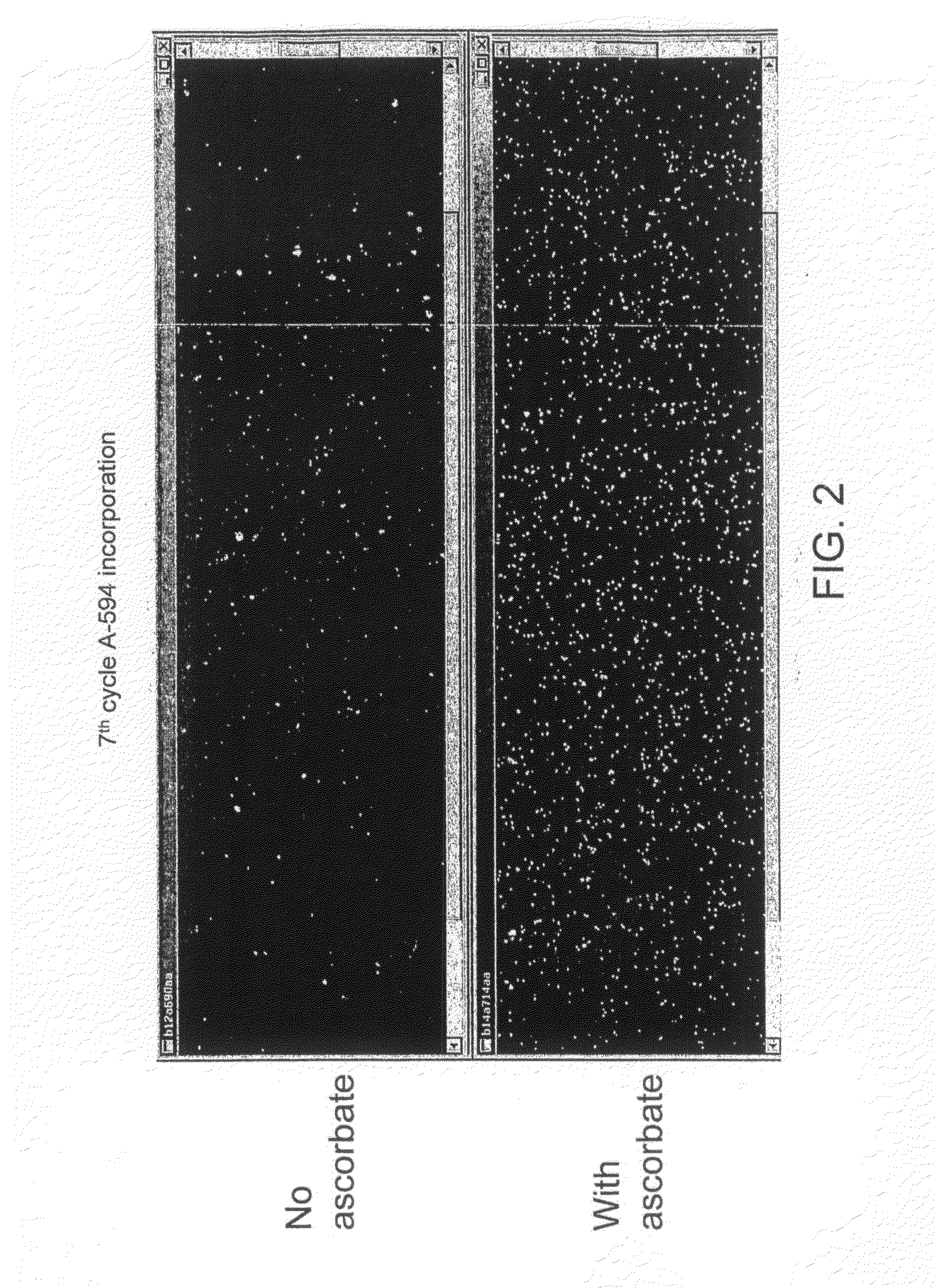Method of Nucleotide Detection
a nucleotide detection and nucleotide technology, applied in the field of additives, can solve the problems of unable to accurately score the identity of the incorporated base, light-induced damage to the nucleic acid template, and previously suggested adding antioxidants to buffers used for detection/imaging of fluorophores incorporated in or attached to nucleic acids
- Summary
- Abstract
- Description
- Claims
- Application Information
AI Technical Summary
Benefits of technology
Problems solved by technology
Method used
Image
Examples
example 1
Sequencing on Arrays Prepared on Silane Coated Glass Chips
1) Formation of Nucleic Acid Clusters
[0109]Solid-phase amplification was carried out in 8 channel glass chips such as those provided by Micronit (Twente, Nederland) or IMT (Neuchatel, Switzerland) coated with aminopropyltriethoxysilane derivatised with 1,3,5-benzenetriacetic acid (BTA). The experimental conditions and procedures are readily applicable to other solid supports.
[0110]The reaction steps of the coating procedure are summarised as follows:
Step 1: Conversion of Glass to Amine-Terminated Glass
[0111]
Step 2: Preparation of Active Ester
[0112]
Step 3: Conversion of Amine-Terminated Glass to Carboxylated Glass
[0113]The 8 channel glass chips were pre-treated and silanized with 5% aminopropyltriethoxysilane, as described in the materials and methods of WO 00 / 18957 (incorporated herein by reference).
[0114]Ester activation of BTA was carried out by reacting the following components:
1,3,5-benzenetriacetic acid (BTA)60.5mgFluka ...
example 2
Sequencing on Arrays Prepared on a Hydrogel Coated Glass Surface
[0165]The solid supports used in this experiment were 8-channel glass chips such as those provided by Micronit (Twente, Nederland) or IMT (Neuchatel, Switzerland). However, the experimental conditions and procedures are readily applicable to other solid supports.
Acrylamide Coating of Glass Chips
[0166]Chips were washed as follows: neat Decon for 30 min, milliQ H2O for 30 min, NaOH IN for 15 min, milliQ H2O for 30 min, HCl 0.1N for 15 min, milliQ H2O for 30 min.
Polymer Solution Preparation
[0167]For 10 ml of 2% polymerisation mix.[0168]10 ml of 2% solution of acrylamide in milliQ H20[0169]165 μl of a 100 mg / ml N-(5-bromoacetamidylpentyl)acrylamide (BRAPA) solution in DMF (23.5 mg in 235 μl DMF)[0170]11.5 μl of TEMED[0171]100 μl of a 50 mg / ml solution of potassium persulfate in milliQ H2O (20 mg in 400 μl H2O)
[0172]The 10 ml solution of acrylamide was first degassed with argon for 15 min. The solutions of BRAPA, TEMED and p...
PUM
| Property | Measurement | Unit |
|---|---|---|
| Molar density | aaaaa | aaaaa |
| Molar density | aaaaa | aaaaa |
| Molar density | aaaaa | aaaaa |
Abstract
Description
Claims
Application Information
 Login to View More
Login to View More - R&D
- Intellectual Property
- Life Sciences
- Materials
- Tech Scout
- Unparalleled Data Quality
- Higher Quality Content
- 60% Fewer Hallucinations
Browse by: Latest US Patents, China's latest patents, Technical Efficacy Thesaurus, Application Domain, Technology Topic, Popular Technical Reports.
© 2025 PatSnap. All rights reserved.Legal|Privacy policy|Modern Slavery Act Transparency Statement|Sitemap|About US| Contact US: help@patsnap.com



